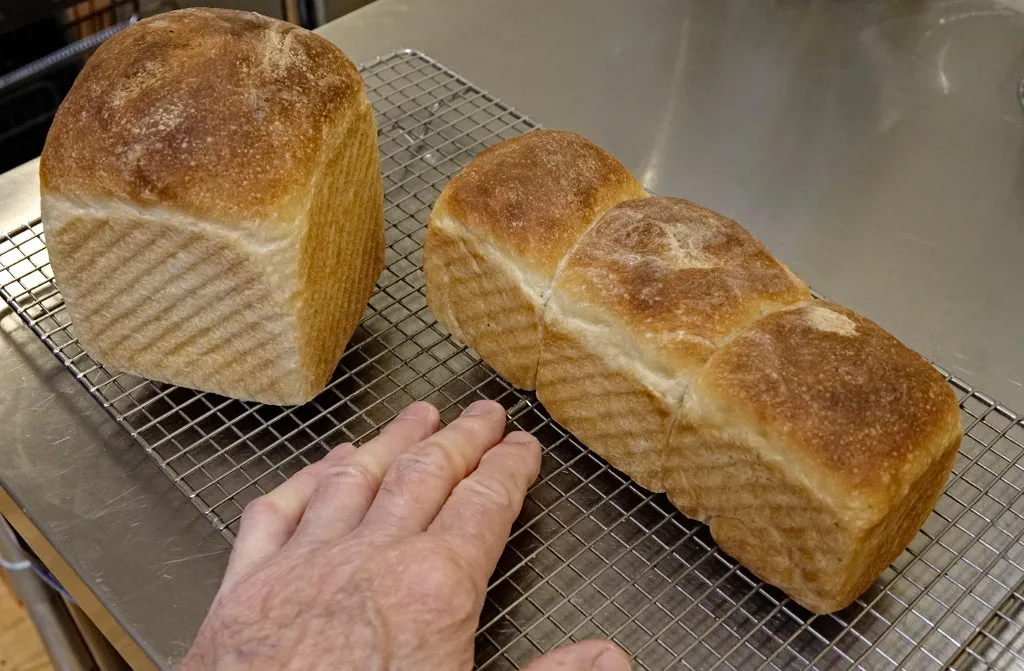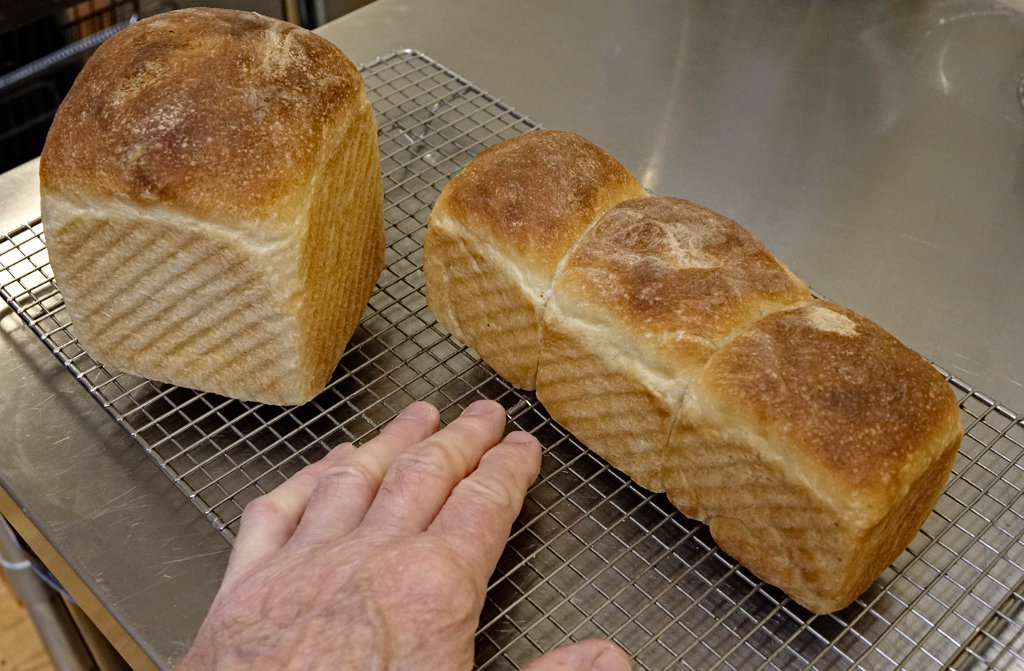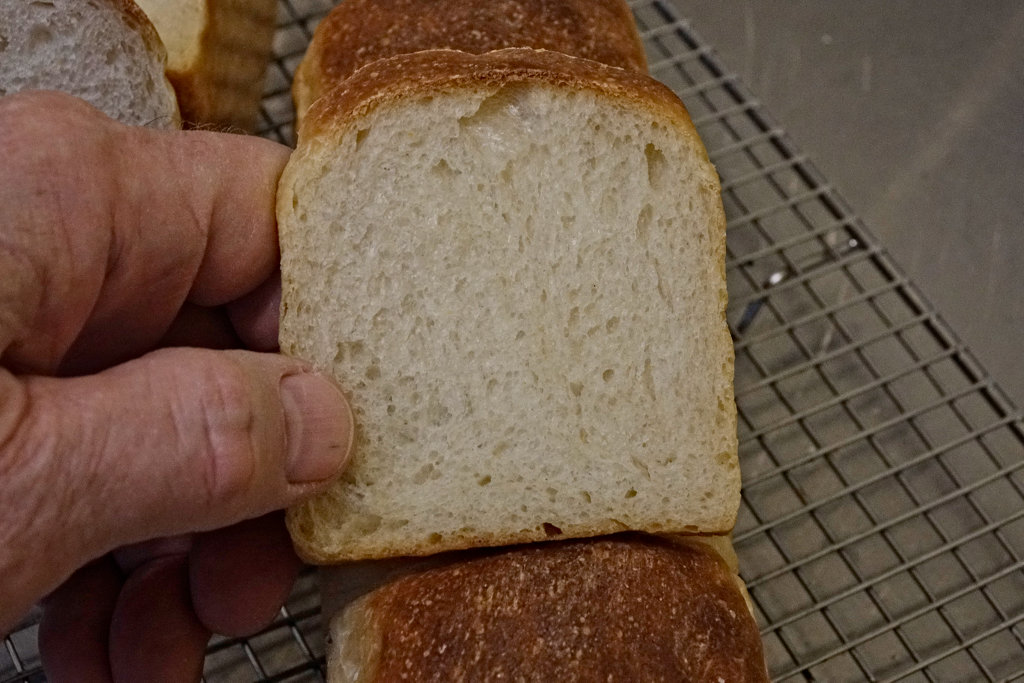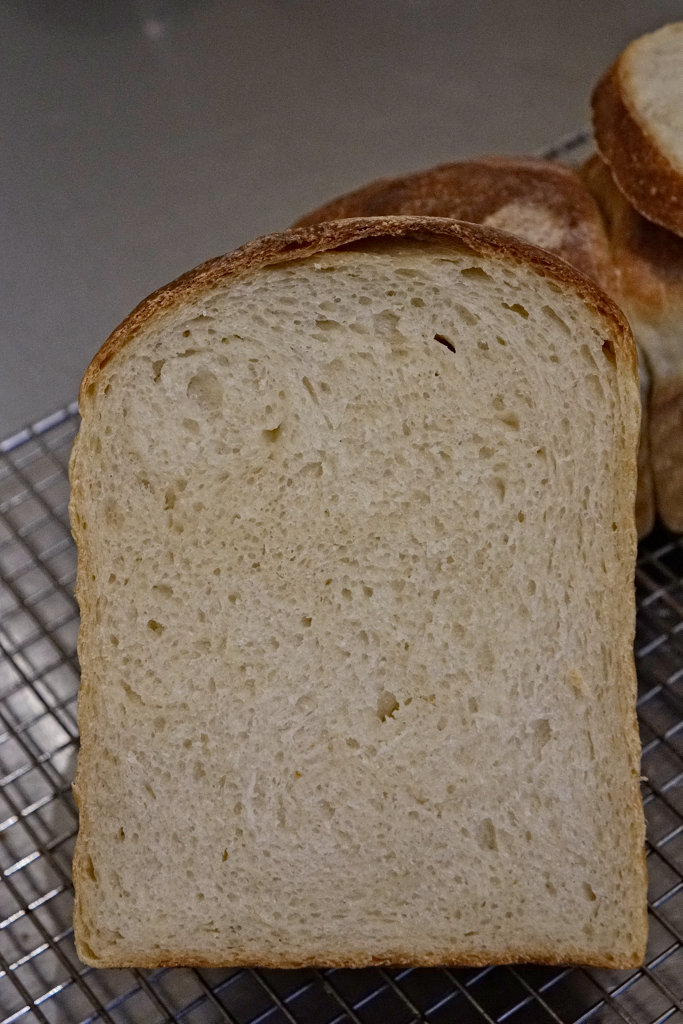
Recently there was a TFL thread that linked back to txfarmer's post from long ago in pain-de-mie, or slightly enriched soft shreadable sandwich loaves. Here's the link:
https://www.thefreshloaf.com/node/20669/sourdough-pan-de-mie-how-make-quotshreddablyquot-soft-bread
I've made enriched loaves before but not thinking of them as pain-de-mie. Also, in the past mine haven't been very shreddable. So I decided to take a try and used her recipe (pretty nearly) though I changed the production process some. Note that txfarmer's recipe is less enriched in sugar, butter, and milk than many of the recipes out there. Also it doesn't include an egg. The lower enrichment favored hand mixing and kneading, which was my preference.
Because this was an experiment I didn't want to make too much dough, and I also wanted to use my new 4 X 4 X 4 Pullman pan. So I made enough dough for a 4 X 4 X 9 Pullman and split it evenly between the short 4 X 4 and a 3 X 3 X 8 Pullman.
Pictures then details -



(No pic of the bread being shredded, sorry).
The result was pretty good, a mildly enriched soft bread that slices easily and can tolerate shredding off a strip - though not as shreddable as txfarmer's, I think.
The recipe used 450g of flour (not counting the starter; see below). Sugar, butter, and dry milk powder were at 5%. Flour was 50-50 KA bread and Gold Medal AP. Starter - well, that's a story!
I had refreshed my starter late the night before, a 90% hydration, bread flour starter with 1% added salt. I didn't plan to make bread so I didn't make very much starter. Next morning I decided to make this bread and by after lunch when I was ready to go, the starter was well past peak and I didn't have enough. I did have another starter I had refreshed at the same time, my experimental masa hariña starter (more at https://www.thefreshloaf.com/node/76330/masa-harina-rye-loaf-masa-harina-starter). I knew that this starter would raise the bread well but might change the flavor. Oh, well, I had to use it. Here's the recipe, scaled fairly closely from txfarmer's:
Recipe
--------
- 450g - total flour
- 225 AP
- 225 KA bread flour
- 150g (33%) - total starter
- 90g - AP starter (100%)
- 60g - masa hariña starter (200%) (masa soaks up lots of water!)
- 290g (64%) - water, warm to the touch (to offset coolish 71 deg F work area)
- 25g (5.6%) - sugar
- 25g (5.6%) - KA dry powdered milk (outdated)
- 25g (5.6%) - butter, room temp
- 9.5g (2.1%) - salt
I didn't follow txfarmer's procedures all that closely. Instead I used my standard methods with little modification except for more initial kneading. I wanted to see if I could incorporate the butter and get a good shreddable crumb without working hard at it. For instance, I never checked for a window pane, and even late in the S&F series the surface seemed to develop small tears easily. Yet in the end the dough was delightful to work with, and the crumb came out excellent.
Process
--------
- 12:55 PM - Mix all except butter
- 1:35 - knead/S&F on bench. Very sticky
- 2:45 - Laminate folds to work in softened butter.
- 4:00 - S&F in bowl.
- 4:50 - S&F on bench. Slow stretches but skin still likes to tear. No longer sticky. Into bulk ferment tub.
- 5:40 - S&F in tub. Dough feels smooth, oily, soft. Probably started to rise.
- 7:00 - scale, preform - 3 balls for 3 X 3 X 8 pan, 1 ball for other ++
- 7:10 - form, into buttered pans, cover
- 7:45 - preheat 375 °F without steel.
- 8:15 - bake 350°F no lid 32 minutes
++ Dough had more than doubled. Each of the three smaller balls weighed close to 150g.
As you can see, the dough rose fairly quickly despite the starters having been over peak. I think there was too much dough in the end, and I would probably reduce the amount a little next time, especially when I want to bake with the lid on. Without a lid I plan on using an egg wash in the future, which will make the tops look more inviting.
TomP
- tpassin's Blog
- Log in or register to post comments
I'm impressed at your skill with kneading, wouldn't even think of incorporating butter by hand! Also if I recall the txfarmer recipes went through a stage where a lot of mechanical kneading was involved, which makes the fact that you could achieve a shreddable loaf entirely by hand even more impressive.
-Jon
Thank you, Jon! Yes, she did emphasize kneading and a very robust window pane. One reason I wanted to try her recipe is that it doesn't use very much butter, only 5%, and that should be easier to incorporate. One thing I've learned in the past is that it's not necessary to force the butter to be completely absorbed all at once. It continues to absorb while the dough is resting between S&F sessions. This makes using do-it-all-by-hand procedures more feasible.
In working up the dough I didn't put much more effort into kneading than I usually do. After rough mixing (and preferably letting the rough dough rest for half an hour or so), the dough tends to get stiff quickly when kneaded. If you keep forcing it to bend and stretch it can start to tear. It really needs to rest again. I did keep forcing it a few minutes longer than I usually do, but that and working in the butter are really the only changes I made to my regular routine.
(Not that I'm advocating making pannetone entirely by hand).
I too knead my pullman loaves by hand, and like you, incorporate the butter easily after an initial mix, rest and brief knead. Indeed, the butter incorporates easily without much effort.
I've found that shredability for hand kneaded soft loaves without much upfront kneading depends quite a bit on a spectacular bulk rise. Tenderness of crumb might always be there with fat, sugar and higher hydration, but shredability - for me, i.e. really without much kneading nor enrichment - depends on a tripled bulk rise.
That's good for me since I have a tendency to let the bulk rise go that far. I haven't had any dough collapses.
I can't tell from the picture how you shaped the square loaf. Was it rolled and placed in the pan the way the others were? And was there any difference in texture between the two loaves? I ask because I'm interested in shreddabiliy as it relates to slicing bread with or against the grain, inasmuch as bread dough has a grain. Whenever shreddableness is demonstrated, it is always with the grain--the equivalent of slicing an ordniary pan loaf along its side, instead of end.
The interesting thing about a square loaf that has been rolled is it can be sliced with or against the grain depending which side you randomly choose to slice. If you shaped the square dough without rolling, just a ball, theoretically it should be less shreddy than the other loaf. Or, I could be full of hot air.
I shaped the dough for the square loaf into a ball and let it settle into the pan bottom side down. I'm not sure just how that leaves the grain, but it wouldn't be as well defined as for a rolled loaf.
For shredding, I used
a slice fromthe smaller loaf, the one with the three rolled lobes. Isliced it vertically, andpulled out a shred by pinching into the middle and tearing it outward and down. The thin piece peeled out and away from the body, and looked just like the picture in the txfarmer post, but not as large. I'm fairly sure that this bread isn't as dramatically shreddable as hers or one of Benny's recent bakes. I suppose that's because I didn't knead it by machine. But it's not bad, either.Tom these loaves look just lovely, well done that they were fully done by hand. While I have done this in our place in Fort Lauderdale (which we’ve now sold) I never enjoyed making enriched doughs by hand. I always find that the dough needs to be very very well developed to be very shreddable.
Benny
Thanks, Benny. Yes, these were done fully by hand. I can see that yours were more dramatically shreddable but I'm not complaining about these. And if there were a higher percentage of butter, of course working it in would have been harder. With the butter at 5% or so I was able to apply it all at one go. The key was the lamination, namely stretching the dough out into a big rectangle first. I dabbed or spread all the soft butter onto it, did a letter fold or two, and then some more stretching for a few minutes. By the last of the 3 later S&F sessions, the butter had all been absorbed and the dough was lovely to handle.
Well done, TomP - the crumb looks very authentic - and reminds me I need to try one of these pain de mie's again.
Lance
Thanks, Lance. BTW, these loaves are tasting better after a day or two. This isn't the first time I've noticed an aging effect but not so much lately until now. I suppose it's an effect of the acidity of the sourdough.
Lots to think about with these loaves. You know I love lamination and adding butter to the dough like that is such a great idea! I love tx’s formulas. I’ve used a number of them only for their ingredients I never use the process she used because… you know…. Minimal hands on!
Love your tiny pan. I keep forgetting to look for those. I’m doing something new tomorrow. Will post it when I see how it goes. c
Thanks, Caroline. My little pan is from Chefmade - they call them "toast boxes", not "Pullmans" - and takes about half the dough of a 4 X 4 X 9.
I love how you incorporated your corn starter into this formula. Very impressive with hand mixing indeed.
Happy baking.
Ian
Thank you. I'm still not sure about keeping the masa starter, but it does a fine job of leavening.